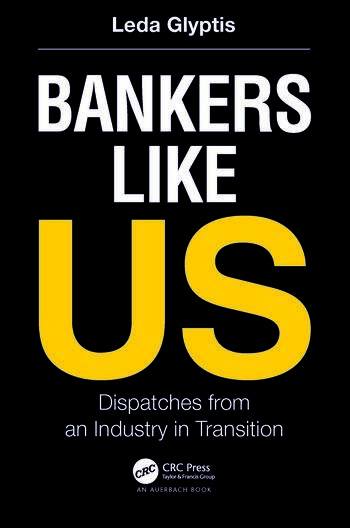Bankers like us: there’s no stopping us now
Happy new year #mytribe! I know January is meant to be a month for the post-Christmas lull full of blues and weight-loss commitments… but I, for one, am full of beans. Because 2023 is the year when my book comes out and I am giddy like a child on Christmas morning.
Yes yes yes: I wrote a book! And I know some of you are saying, “about damned time”, and yes, well, also true… but better late than never and here it is now.
It is written.
It is ready.
It is being printed and will be in your hands in the next few weeks, if you want it and it can be pre-ordered right now (and the FinTech Futures readers can get 20% off with the discount code FTF20).
It feels extremely grown up, to have a book out. And although, theoretically, this is not my first rodeo (I have written a PhD after all), this was a radically different experience.
It started as a thematic collection. We wanted to look back to the last five to six years of #LedaWrites and pick the themes and ideas and turns of phrase that had resonated the most with you and weave them into a bigger narrative. That was the idea. That’s where I started. And worked at it. And worked at it some more.
I kept working at it, but it didn’t quite work.
I don’t know why. It just didn’t. it felt flat, it didn’t flow. It just didn’t add up to more than the sum of its parts.
It was actually less and I wasn’t having any of that.
You see writing a book when you already have a community of readers feels like a dialogue. You don’t know it yet. But this book is for you. It’s also about you. So it needed to work. It needed to resonate. And it didn’t.
Where did that leave me?
Don’t know.
But I know where it led me. And that is to a book that deals with a lot of the themes of this column but on a different scale.
So this is where we got to.
The economy is digitising faster than the banks.
The reason for this?
Bankers.
Humans. Ordinary people. The ambitious and the 9-to-5ers, the veterans and those starting out. The people who man the edifice, the humans who populate the structures. Not just the leaders and decision-makers but everyone who works in a certain way, everyone who perpetuates what was passed down unthinkingly because “that’s the way we do things around here”.
Their habits, acquired, honed and passed on. The organisational foibles and structural idiosyncrasies that determine process. The way things are approved, measured and assessed. The way people are hired, measured and rewarded. The way people learn to say no before they hear a question. The way people learn to separate what is needed for the business and what is needed for personal survival within the business.
The book goes into detail, in case you are tempted to disagree with any of this. Details and examples and more examples. You know I’m right but go on, read and if you disagree, let’s talk about it.
I do stand firm by that statement though.
The reason banks are digitising slowly is not technology’s inadequacies or a problem with user adoption as the very same tech and the very same humans are doing fine outside the banks’ hallowed halls. The problem is the bankers slowing down the adoption within their own walls.
So what is the solution?
Also that.
Bankers.
What man maketh, woman can unmake and whatnot. I jest. Men too. They can unmake also.
The solution to all the challenges and foibles that hold us back will come from the people already in the room. Us.
So the second half of the book is about that. Resistance. Change. Transformation.
In that order.
The things we can all do on the individual level, starting today. Small acts of resistance that go a long way. The things we can all do on the team level and the organisational level. Material change that will move the organisation and the people within it forward in a meaningful way. And things we can do as a community. As a society. To really transform banking.
Some of it you can do alone. Some with a band of committed trench buddies. But a lot of it takes a village and we never said it would be easy, we said it would be worth it… and every other cliche you can think of. It’s all true.
So that’s what the book is about. A layered, specific call to action. It’s not a rousing speech, you understand. It is a specific list of things that can and should be done. If you want to, it can serve as a manual. A to-do list.
The attentive reader may pick up some themes, organising ideas, the occasional whole paragraph that may feel familiar. I had a few times a strong feeling of “this has to go in as is” and occasionally the feeling of “wait, I am pretty sure I have written this before… better…”. God knows I felt like I was plagiarising myself on occasion because, since I decided this was a whole new piece, how can I borrow even a little of what was said before. Was I not robbing you, my readers?
I decided not.
I decided this, borrowing some themes and paragraphs from myself, is how I got to build on all the thinking that has been done in these columns before and taking it to the next level.
And I hope you feel the same as you read this, my first book.
Oh there will be more. There’s no stopping me now.
Thank you, #mytribe. For getting me this far. For getting your teams and your organisations and your communities this far.
I hope you stick around and keep doing what you do, #mytribe.
Because then there’s seriously no stopping us.
#LedaWrites

Leda Glyptis is FinTech Futures’ resident thought provocateur – she leads, writes on, lives and breathes transformation and digital disruption.
She is a recovering banker, lapsed academic and long-term resident of the banking ecosystem. She is chief client officer at 10x Future Technologies.
All opinions are her own. You can’t have them – but you are welcome to debate and comment!
Follow Leda on Twitter @LedaGlyptis and LinkedIn.












































